PRECLEANER
When the conveyed ore is so sticky that it doesn’t fly off at the discharge pulley, normal scraper systems struggle to remove it from the belt. This usually means that the whole conveyor belt system gets clogged with carryback, and ends up with an unscheduled stop for cleaning. Tecnipak has developed a specialty precleaner that has been designed to cut through the thick layer of ore, releasing the bulk of the material from the belt, and allowing it to continue its journey through the chute.
The cleaning edge is composed of several blades placed next to each other, each of which have a beveled attack edge made from solid tungsten carbide blocks and a ceramic layer that protects the frame of the precleaner from wear. There is no other cleaner in existence capable of dealing with the impact and abrasion that results from the removal of the bulk of the conveyed ore.
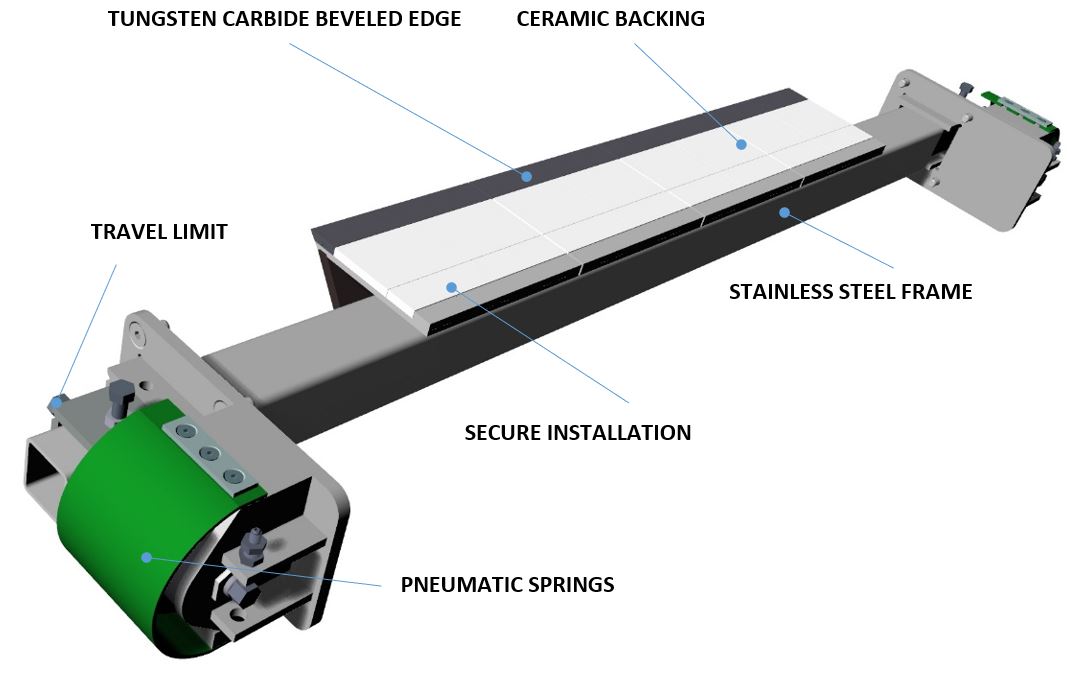
TRAVEL LIMIT
Allows the precleaner to perform safely millimeters away from the pulley.
TUNGSTEN CARBIDE BEVELED EDGE
Solid tungsten carbide blocks cut through the ore even in the worst operational conditions.
CERAMIC BACKING
Protects the precleaner frame from wear.
PNEUMATIC SPRINGS
Allows the precleaner to yield so that elements that get trapped between the precleaner and the belt can be expelled.
SECURE INSTALLATION
Each blade’s bolts go through the frame and are fastened from underneath, which protects them from abrasion and wear.
STAINLESS STEEL FRAME
Three-, four-, or five-inch square profiles available according to belt size, tonnage, and speed.
• Specialty cleaner. Designed to improve cleaning when the bulk of the conveyed ore doesn’t fly off the discharge pulley, the precleaner cuts through the bulk and allows for the primary cleaner to perform in normal conditions. Highly favored in leaching operations where there is particularly cohesive and sticky, there is no other cleaner that works as efficiently and reliably in these conditions.
• Tough. The frame is made from a three-, four-, or five-inch stainless steel square profile with thicknesses from 1/4“ to 3/8”. Tecnipak guarantees that it will withstand even the most aggressive mine duty.
• Pneumatic springs safety mechanism. The precleaner works millimeters away from the discharge pulley and has pneumatic springs that allow it to yield so that any elements that get trapped between the belt and the precleaner are expelled.
• Remote adjustment. The adjustment controls can be installed in a safe place, away from the hazard zone, which allows the precleaner to be adjusted while the belt is running.
• All-around reliability. Every part has been designed and developed to perform with minimal maintenance and a wide tolerance to changes in the working conditions.
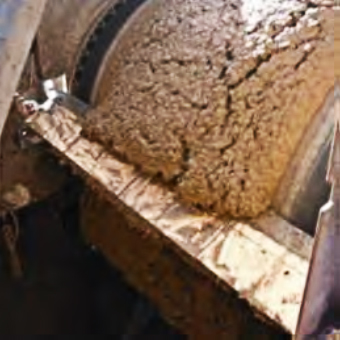
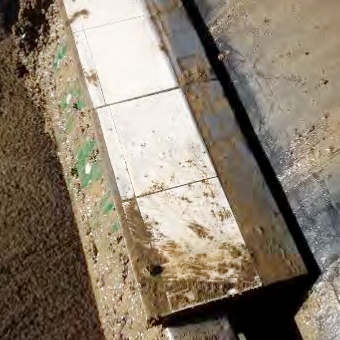
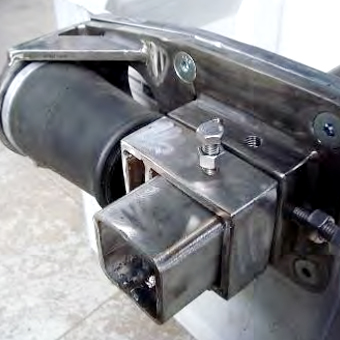
SPECIFICATIONS:
- Belt speeds up to 7.5 m/s (1,450 fpm)
- Belt widths from 900 mm up to 3,150 mm (36’’ up to 124’’)
- Pulley diameters from 800 mm up to 3,000+ mm (32’’ up to 118+’’)
WORKING PRINCIPLE
1. The cleaning edge is composed of several blades, each with a tungsten carbide beveled edge that is adjusted so as to be a few millimeters away from the pulley.When the moving ore encounters the precleaner, the cleaning edge cuts through the ore and hence detaches the bulk of the conveyed material so it can be driven into the chute.
2. Once the bulk of the ore has been detached, the precleaner has to redirect the ore over the precleaner and into the chute. This exerts a great force on the surface of the blades, which also generates an important abrasion stress. Ceramic tiles withstand the abrasion while at the same time pass down the force onto the frame being held by the adjustment consoles through the pneumatic springs.
3. Finally, the ore is clear from the precleaner and continues its journey through the chute. Over the belt remains a thin layer of ore, which is later removed by the primary and secondary cleaners.
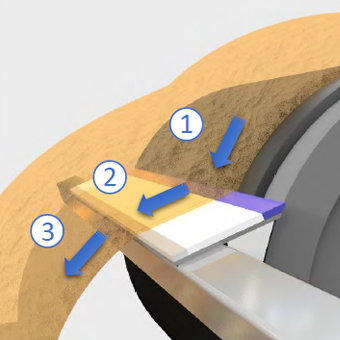
PNEUMATIC SPRINGS SAFETY MECHANISM
In cases where a rock gets jammed between the precleaner’s cleaning edge and the pulley, it is necessary that the rock can be released to avoid damage to the belt.
Thanks to the pneumatic spring safety mechanism, when a rock gets stuck and the pulley pushes it further between the pulley and the cleaning edge, the frame of the precleaner yields.
The pneumatic springs absorb the displacement of the precleaner until the rock is expelled, at which point the springs restore the precleaner to the working position.
All of this happens in a fraction of a second, so the cleaning quality is never impaired.
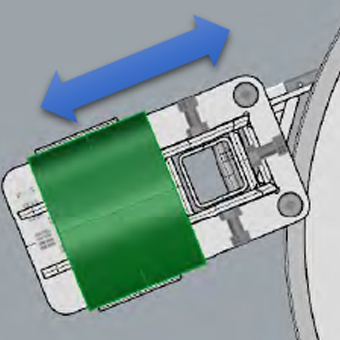
FAQs
Which precleaner size should I choose? The precleaner should wipe the entire width of the belt, so it should have the same width as the belt.
At what angle should the precleaner be installed? The precleaner must be installed with an installation drawing supplied by Tecnipak for each particular installation. However, it is desirable that it operates between 25 to 45 degrees from a horizontal plane.
The blades in the center wear out faster than the ones on the sides. What should I do? This behavior is normal and should be expected, because the bulk of the load travels centered on the belt and this wears down the blades on the center faster. To make the blades last longer, when the center blades are worn, a rotation should be performed in which the center blades take the place of the outer blades and vice versa. For more information, please review the manual or give us a call.
